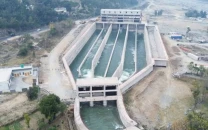Floods and failures
K-P government has announced Rs800 million in relief funds for affected districts

The devastation unleashed by flash floods in Khyber-Pakhtunkhwa has reached staggering proportions. At least 325 lives have been lost, over 150 remain missing and hundreds more lie injured as the province battles one of the most destructive monsoons in recent memory. Nationwide, the death toll has climbed to 657 since late June, including 171 children and 94 women - a grim reminder of the sheer human cost of our collective unpreparedness.
The K-P government has announced Rs800 million in relief funds for affected districts and an additional Rs500 million for Buner, one of the worst-hit regions. While such allocations offer some respite, they remain little more than a stopgap move against the magnitude of suffering on the ground. Relief trucks and helicopters have been mobilised, yet vast swathes of the province remain cut off, with communities stranded and vulnerable to further deluges. With two to three more waves of heavy rain forecast in September, the dangers are far from over. Prime Minister Shehbaz Sharif has directed his cabinet members to personally supervise relief operations, but this belated move highlights a deeper malaise. Year after year, Pakistan finds itself trapped in the same cycle of disaster and damage control. Yet lessons from the catastrophic 2022 floods appear to have been quickly forgotten.
The response must now shift from ad hoc measures to systemic resilience. Emergency funds cannot substitute for disaster-proof infrastructure, nor can helicopters replace the need for climate adaptation strategies in vulnerable regions. K-P, with its mountainous terrain and fragile riverbanks, will continue to suffer unless the state invests in robust early warning systems and better urban planning. Unless disaster preparedness is embedded into policy, the toll of lives and livelihoods will continue to mount each year.














COMMENTS
Comments are moderated and generally will be posted if they are on-topic and not abusive.
For more information, please see our Comments FAQ